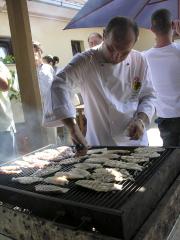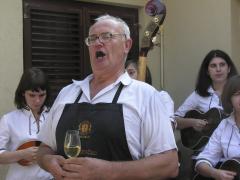Croatia Diaries Part 4: The Final Frontier
POSTED ON 23/08/2009Next week Decanter Magazine unveils the results of its World Wine Awards, in which Croatia is hailed as a major force in wine because it won more gold medals than more established rivals, among them the United States, New Zealand, Portugal and Argentina. This is a major achievement of course, but it will come as no surprise to the Croatians themselves, who’ve been making excellent wine over the past couple of decades. War followed by reconstruction however, not to mention a huge domestic thirst for their own wines and relatively high prices, have meant that these wines are relatively little-known outside their own country. But let’s not get too carried away. Most of not all the gold-medal winning wines were sweet wines, repeating the success that Austria had a while ago in showing that many, but not all, of its greatest wines were made in the sweet style.
 Zagreb
Zagreb
Last week, I reported how we had travelled back to Zagreb for tastings of graševina and plavac mali following our exertions in Istria. We desperately needed to put our feet up for the day in Zagreb because on our last full day in Croatia, we were to embark on a major trip to Kutjevo, several hours due east of Zagreb in the Slavonian region, followed by a further drive to the final frontier of Ilok (btw, as I like to write backwards, you’ll find that leg of the trip covered). Kutjevo is in the middle of Slavonia and part of Continental Croatia, as distinct from the Coastal region, which includes the more touristy Split and Dubrovnik, not to mention the Peljesic Peninsula and the pretty islands of Hvar, Korčula, Brac, Hres and Krk.
 Vlado Krauthaker's vineyards, Kutjevo
Vlado Krauthaker's vineyards, Kutjevo
At the foot of Mount Kmdija, Kutjevo is home to a number of monuments and the famous Kutjevo wine cellar built by the Cistercians in 1232. This is one of Croatia’s most famous wine-growing districts, which we reach after something like a three hour drive, by which time we’re getting a bit peckish - just as well, as you will see. Before the Rabelaisian lunch that ensued – and we had come to expect it by this time, we were first shown the vineyards belonging to one of the district’s best winemakers, Vlado Krauthaker. On the 45th parallel, The Kutjevo Valley looks a little bit like the Vosges Mountains of Alsace, south-facing vineyards rising from the plain up the imposing hillsides of low mountains such as Kmdija and stopping when it becomes too high and wooded for viticulture. It’s relatively humid with rich sandy clay soils, climatically continental and not dissimilar to Burgundy, which it also resembles in parts.
Here the main grape varieties are graševina, aka welschriesling or riesling italico, chardonnay, pinot crni (pinot noir), pinot sivi (pinot gris), rajnski rizling (riesling) and merlot. Main producers here are Krauthaker, Adžić, Bartolović, Jakobović, Lukačević, Majetić, Mihalj and Kutjevo itself. Krauthaker himself has 75 hectares of vineyards, around two-thirds planted to graševina, in an area that covers 1,650 hectares in total. Working the vineyard with his own horses, he is aiming for low yields, and for that purpose is changing the density of his vineyards from 4,500 vines per hectare to as high a density in some parts as 10,000 vines per hectare. After a visit to the vineyards, we head to the tasting room, where we taste 101 Dalmatians. Only joking. No, actually we taste a fascinating assortment of wines, sauvignons, chardonnays, rieslings, pinot noirs, terans, blends and the native zlatina, pošip and babić, the latter the name of a producing family in New Zealand but the second most important red variety in Dalmatia after plavac mali (see tasting results at the end).
 squid and bream on the grill
squid and bream on the grill
We have earned lunch and, serenaded by a local all-girl string band, sit down with winemakers to a copious plate of antipasti, followed by two delicious soups, one a consommé, the other a more rustic but filling potato soup. When by this time a large plate of date mussels appears, someone has to good sense to inform us that these are only just starters and that the celebrated chef from Split, Zlafko Marinovic, is outside preparing the barbecue. And some barbecue this turns out to be. We file out into the small courtyard behind the tasting room, to find Zlafko preparing fresh squid and white fish on the barbecue and a gigantic spit containing huge great chunks of gorgeous-smelling pork sizzling close to an open fire. We help ourselves to the char-grilled squid and white fish, the wow moment made all the more wow when the spit is taken down and each giant piece of meat reserved to a dish from which we help ourselves to some of the most memorably, meltingly tender and beautifully char-grilled pork you’ve ever sunk your teeth into.
 sizzling pork
sizzling pork
The serenading continues, this time the winemakers lustily joining in. There are unbelievably rich cakes of course for those who can manage them but at this point I have to declare myself defeated. Once again, I’ve lost all sense of time, and I’m sure we’re three hours late again as we clamber into the bus for our assault on the Kutjevo Cellars. Looking like a cross between a Russian orthodox church and a winery, Kutjeko is vast a huge property that makes its wine from 1,200 hectares of vineyards of which 600 hectares are privately owned. As you might expect, it has an extraordinarily convoluted history, starting with the Cistercians in the 13th century, following which the Turks took over and ran it for 160 years until 12 March 1688. Then it became the turn of the Jesuits before it became part of the Austro-Hungarian empire, the stories all told in intricate wood carvings on the oval upright fronts of the cellar’s Slavonian oak barrels.
 serenaded
serenaded
This is when the renowned Slavonian police chief, Baron Trenk, is supposed to have holed up with Habsburg Empress Maria Teresa for an affair which not only scandalised the locals, but led to all sorts of rumours about both his and her sexual prowess. This isn’t the place to go into detail, suffice to say that when Ivona told us that the old stone table with a hole in it was the subject of a number of stories and rumours surrounding the passionate couple, she went as far as to say that one of the reasons the table was supposed to have got its hole was because Maria Teresa’s ‘ass was so hot it burned a hole in it’. The other reason she declined to elaborate on and it was left to our host, and our fertile imaginations. She did say however that if you make a wish and put your hand on the table, its cosmic energy will make your (sexual of course) dream come true.
 over a barrel- Kutjevo Cellars
over a barrel- Kutjevo Cellars
We tasted a few wines in the cellars here, a couple of pinot noirs, a couple of graševinas from 2006 and 2008, a 2007 traminer, a suspiciously youthful 1965 pinot noir, but the most interesting wines were an excellent, petrol and lime marmalade 1992 rhine riesling and a 1979 muskat ottonel, which was still fresh, albeit with a sherried hint of oxidation, but lovely truffley, earthy flavours, quite rich, and deliciously dry. One of our party, Simon Tam, became so enamoured he decided on the spot he was going to take some of this back to Singapore and put in an order of a couple of bottles, which, as it turns out, you can buy at the Cellars shop relatively cheaply. And so it was on, to the final frontier of Ilok, and our entertaining meeting with Miss Croatia. (http://www.anthonyrosewine.com/journal/2009/7/miss-croatia-and-i-%E2%80%...).
A Tasting in Kutjevo – 4 July 2009
1. Zlatina, Sipun 2008, Krk. 12.1%
Variety from coastal region planted only on Krk island. Gentle variety, low acidity and used only for specific style. Fresh and peardroppy on the nose, nice light refreshing spritz, drinkable and nice dry refreshing, almost sherbet lemony finish. Not long but juicy. 87.
2. Sauvignon, Korak 2007, Plešivica. 12.9%
Near Zagreb. Quite catty, elderfloral and cut grass sauvignon aromas, nicely fresh, good fresh spritz, nice grassy, herbal Loire-like character, crisply refreshing and dry, could be a Sancerre, flinty, dry finish. 88
3. Sauvignon, Krauthaker 2007, Kutjevo. 13.5%
Riper, smoky Graves nose, more gooseberry fruit, and less varietal sauvignon, still fresh and crisply dry for the vintage, slightly smoky, Grave-style, quite nicely textured and rich with good savoury acidity, a Graves-style food wine, with nice freshness. 88
4. Sauvignon 2006, Vinarija Daruvar, Daruvar. 13%
Between Zagreb and Kutjevo, first wine region in Slavonia. Showing age on golden colour, some mandarin, very full and fat, almost off-dry, opulently ripe, rich and fat; a tad broad and lacking freshness and focus. 86
5. Pošip Intrada, Krajančić, Korčula. 13.8%
Parents: zladarica and bratkovina. Grown on sandy soils of Korčula near Hvar. Very much a Dalmatian white variety with good potential. Nice fresh sauvignon-like aromatic quality, slightly herbal and lemony, fresh spritz, good fresh, juicy dry fruit quality hint of gooseberry and blackcurrant leaf, maybe a touch trebbiano-like, Custoza-like, Italian; dry, almost mineral finish. 88
6. Pošip, Korta Katarina, Korčula. 14.7%
Partial barrel-fermented, larger proportion s/steel; powerful, rich full fruit, heavier, fuller, more smoky oak, fair fresh acidity, more in the Graves style, creamy, rich and full-flavoured, but a tad overalcoholic and hefty. 87
7. Chardonnay, Rosenberg, Krauthaker, Kutjevo. 13.5%
Leesy, mealy batonnage nose, good chardonnay fruit, nicely oaked with good refreshing, clean fruit quality; a tad international in style, but well-crafted burgundian style with good touch of malo butterscotch and nice balance. 88
8. Chardonnay Surlie, Korak, Plešivica. 14%
Quite buttery nose, showing its age a bit, with buttery, nutty, oxidative notes; appley fruit quality; quite powerful, with oaky buttery notes, but still has quite good fresh acidity for its age. 86
9. Chardonnay, Bartolović 2007, Kutjevo. 15.1%
Smoky oak and baked apple and clove and custard, hefty alcohol, quite rich and concentrated, traditional meursault style fruit, interesting because the acidity is quite high and almost its saving grace were it not for the overhefty, burning alcohol. 85
10. Chardonnay de Gotho Aureus 2007, Kutjevo DD. 14.1%
Fresh on the nose, appley fruit, pleasantly fresh with some typical buttery chardonnay undertones, nicely textured and not showing too much oak; quite broad and rich, rather lacking in focus and definition but drinkable. 86.
11. Rajnski Rizling, Kasna Berba, Enjingi 2006, Kutjevo. 14%
North and here best results. Good fresh riesling nose, zip-fresh, very nice fresh lime zesty fruit, rich and powerful, off-dry fruit, full, concentrated, stonefruit, citrus-zesty, nice dry elegant finish, very riesling, good foil for Asian foods. 88
12. Rajnski Rizling, Izborna Berba, Enjingi 2002, Kutjevo. 14%
Yellow gold, nice dried apricot nose, fresh spritz, very good dried fruits and marmalade fruit quality, lovely sweetness mingling with fine fresh acidity, super balance, classic Croatian riesling auslese style. 90+
13. Zelenac Izborna Berba Prosusenih (tba), Krauthaker 2007, Kutjevo. 13%. Half-bottle.
Croatian variety. Here in Kutjevo for 200 years and can be found in Austria: rotgipfler. Highest quantity of malic acidity. Rich yellow gold, exotic mango, dried apricot and guava aromas, crystallised fruits, promising richness; intensely rich rather than sweet, exotic mango and dried apricot with a mandarin zest fresh edge to it that integrates and balances the whole enterprise. Intense, lovely. 95
14. Pinot Crni, Korak, 2007, Plešivica. 14.3
Pleasant dry red quality on the nose and palate, nice bright, well-made cherryish fruit, not particularly aromatic pinot or even pinot taste profile, but nice bright red fruits and juucy acidity, a well-made dry red in medium-bodied style. 85
15. Pinot Crni, Krauthaker 2006, Kutjevo. 13%
Nice aromatic quality, red fruits, quit perfumed, good bright savoury sour cherry fruit quality; well-oaked, nicely sour cherry red fruits and savoury. 87+
16. Teran, Dajla 2007, Istravino, Istra. 12.5%
Deep colour. Nice dark fruits nose, good savoury fresh plum and damson fruit quality, very juicy and drinkable, a dolcetto-alike , or teroldego, or refosco, Italianate bright fresh and juicy mulberryish red with very supple tannins and refreshing acidity. Really well-made. 89
17. Teran, Roxanich, Istra. 12.4%.
Lots of smoky new oak on the nose, modern style, aiming at international, with good underlying sour dark cherry and black fruit, wrapped in a veneer of vanilla and smoky oak, with supple tannins and juicy fruit but rather oak-dominated and sacrificing fruit for the international dimension that seems unnecessary with a ‘peasant’ grape that expresses itself best, or seems to, without too much oak. Nice wine, shame about the oak. 87
18. Blended Wine, Menengheti 2003, Istra. 13.7%
Cab sauvignon, merlot and cab franc. Good colour, quite a lot of smoky oak on the nose, again oak-dominated on the palate with lost of vanilla and smoke, slightly obscuring the fruit quality here, which is sweet and savoury at the same time, showing some Bordeaux-esque blackcurrant, supple tannins and good savoury acidity, albeit a tad oak-dominated and charry / smoky. 87
19. Blended wine, Kaptol, Bartolović 2007, Kutjevo.13.2%
Merlot, syrah, cabernet sauvignon. Good, bright, fresh aromatic quality, nicely bright cherryish fruit, well-made with very supple tannins, nice savoury mulberry and cherry fruit quality, easy tannins, very fresh balancing acidity and a juicy, food-friendly quality. Attractive with good savoury ‘terroir’ character. 89
20. Babić, Gracin, 2007, Primošten. 14%.
Aftr Plavac Mali, babić second most important variety in Dalmatia, planted in north of Dalmatia. Intriguing nose, interesting wine. More in the line of Plavac Mali; quite big, thick, dark-fruited, dark cherry and mulberry, hint of sulphur / brett?, nice richness of fruit, well-made, good savoury acidity, almost primitivo-like but more savoury and with nice supple tannins and fresher acidity. 88+
 another gratuitous pic of Miss Croatia, this time with Oz Clarke
another gratuitous pic of Miss Croatia, this time with Oz Clarke

